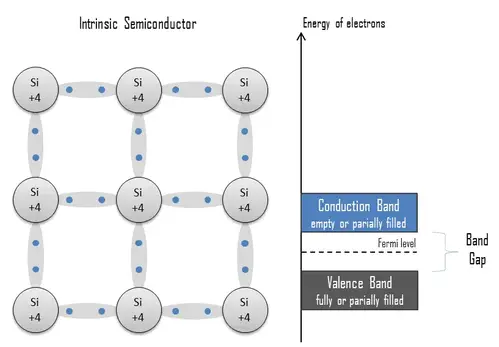Semiconductors
In general, semiconductors are inorganic or organic materials that can control their conduction depending on chemical structure, temperature, illumination, and the presence of dopants. The name semiconductor comes from the fact that these materials have electrical conductivity between a metal, like copper, gold, etc., and an insulator, like glass. They have an energy gap of less than 4eV (about 1eV). In solid-state physics, this energy gap or band gap is an energy range between the valence band and conduction band where electron states are forbidden. In contrast to conductors, semiconductors’ electrons must obtain energy (e.g., from ionizing radiation) to cross the band gap and reach the conduction band. The properties of semiconductors are determined by the energy gap between valence and conduction bands.
Germanium Semiconductor
Germanium (Ge) is a semiconductor material that was widely used in electronic devices in the early days of semiconductor technology, before the widespread adoption of silicon. Germanium has a bandgap of 0.67 electron volts (eV), which is smaller than that of silicon (1.1 eV) and gallium arsenide (1.4 eV).
One of the main advantages of germanium is its high electron mobility, which is higher than that of silicon. This allows for higher electron velocities and faster switching speeds, making germanium suitable for use in high-frequency electronic devices such as radio receivers and transistors.
Germanium also has excellent optical properties, making it a suitable material for use in infrared detectors and other optoelectronic devices. It has a high absorption coefficient for light in the infrared range, which makes it highly sensitive to infrared radiation.
However, one of the main disadvantages of germanium is its poor thermal stability, which can lead to changes in its electrical properties at high temperatures. This limits its use in high-temperature applications. Additionally, germanium is more prone to impurities than silicon, which can negatively affect its electrical properties.
Overall, germanium has largely been replaced by silicon in most semiconductor applications due to its higher cost and lower thermal stability. However, it is still used in some specialized applications where its unique properties are advantageous, such as in infrared detectors and high-frequency electronic devices.
Types of Semiconductors
Semiconductors can be classified into two basic types based on their electronic properties:
- Intrinsic Semiconductors: These are pure semiconductors that are made up of a single element (e.g., Silicon, Germanium) and have no intentional doping with impurities. Intrinsic semiconductors have a specific number of electrons in their valence band and conduction band. They conduct electricity when they are heated, and some electrons gain sufficient energy to break free from their bonds and become free electrons in the conduction band.
- Extrinsic Semiconductors: These are impure semiconductors that are intentionally doped with impurities to change their electronic properties. Extrinsic semiconductors can be further classified into two types:
- p-type semiconductors: In p-type semiconductors, impurity atoms such as boron are introduced into the semiconductor material. These impurities have fewer valence electrons than the semiconductor material, which results in “holes” (absence of electrons) being created in the valence band. These holes can conduct current like positive charge carriers, which gives the material its p-type designation.
- n-type semiconductors: In n-type semiconductors, impurity atoms such as phosphorus are introduced into the semiconductor material. These impurities have more valence electrons than the semiconductor material, which creates excess electrons in the conduction band. These excess electrons can conduct current like negative charge carriers, which gives the material its n-type designation.
Here is a table with 3 intrinsic semiconductors and 2 p-type and n-type semiconductors, along with 4 key properties:
| Semiconductor | Type | Band Gap (eV) | Electron Mobility (cm²/Vs) | Hole Mobility (cm²/Vs) | Thermal Conductivity (W/mK) |
|---|---|---|---|---|---|
| Silicon (Si) | Intrinsic | 1.12 | 1500 | 450 | 150 |
| Germanium (Ge) | Intrinsic | 0.67 | 3900 | 1900 | 60 |
| Gallium Arsenide (GaAs) | Intrinsic | 1.43 | 8500 | 400 | 46 |
| Boron-doped Silicon (p-Si) | p-type | 1.12 | 1500 | 1800 | 150 |
| Phosphorus-doped Silicon (n-Si) | n-type | 1.12 | 1500 | 4500 | 150 |
| Aluminum-doped Gallium Arsenide (p-GaAs) | p-type | 1.43 | 8500 | 200 | 46 |
| Silicon-doped Gallium Arsenide (n-GaAs) | n-type | 1.43 | 8500 | 800 | 46 |



